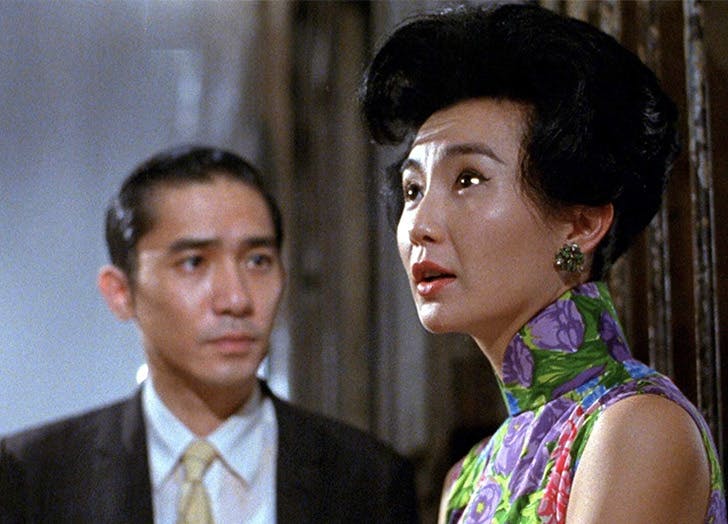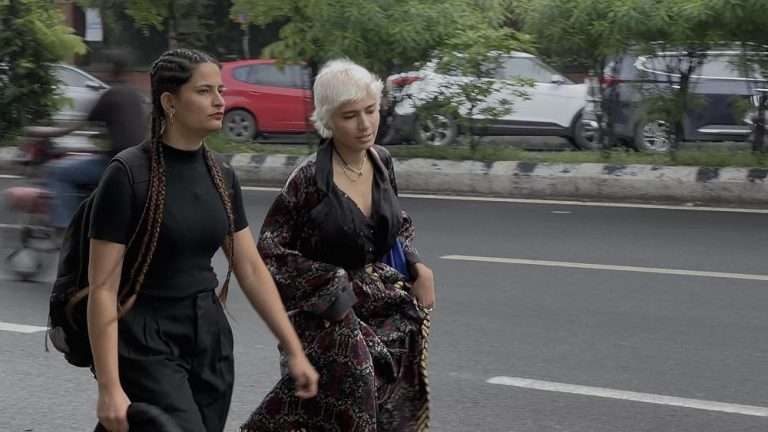In 2017, as the trailer for Vishal Bhardwaj’s Rangoon (2017) dropped, the Indian public was enthralled to receive their very own Bollywood historical-war drama, whose visuals and periodic details seemed to promise a retelling at par with the high-quality foreign films the audience had seen. But apart from stirring a curiosity for the World War II period, the trailer also awakened a mythic figure long thought to be buried in the annals of Indian cinematic history. A figure whose resurrection also spelled doomed for the release of Rangoon, landing it in severe legal trouble. This figure was of Fearless Nadia—one of the earliest action stars of Indian cinema, who starred in a string of commercially successful stunt films for the studio Wadia Movietone.
Miss Julia (Kangana Ranaut), the female protagonist from Rangoon, seemed to bear an uncanny resemblance to Nadia—her mask, her signature whip, her elaborate stunts, and her immense popularity amidst the Indian army soldiers. These similarities were enough for the Wadia family to launch a lawsuit against the filmmakers, even though the latter vehemently denied that the film was based upon Nadia. But the controversy surrounding Rangoon at least attested to one major fact, that despite being one of the many stunt actresses of her time- the oeuvre of Fearless Nadia was in fact unique. Even three decades after her death and her so-called B-movies largely forgotten- the memory of Nadia still loomed large over the film industry. As her grand-nephew Roy Wadia stated in an interview during the controversy, “I agree that there were quite a few other stunt actors and actresses but there was only one Fearless Nadia…”
Related to Fearless Nadia: 7 Important Urmila Matondkar Films
Born as Mary Evans to a British father and a Greek mother, Nadia was born in Australia and relocated to India when her soldier father was drafted to India. After a series of unfortunate events in her life (including her father’s death in the war and the precarious financial situation), Nadia took a series of jobs as a performing artist in a ballerina show, in a circus, and finally, as an actress at the Wadia Movietone, managed by brothers JBH and Homi Wadia. Her unique physique, acrobatic style, and memorable stunts catapulted her to enormous success amongst the masses, while simultaneously propelling the Wadia studio to greater heights. However, the biggest paradox of her massive success was the tumultuous epoch in which they were released.
At a time when the independence and Swadeshi movement was in full swing- no one questioned a white woman kicking and punching ‘brown men’. Further, Nadia’s regular use of phrases like “You Fool!”, “Non-Sense” and “Bloody Hell!”, which are often directed at naïve natives, might seem to suggest a racial superiority, as was often the case with English officers’ haughty use of the language. But despite her whiteness and vocal performance, most of Nadia’s films were rather seen as anti-imperial and pro-independence in their message. Taking a brief look at Fearless Nadia’s filmography and the social conditions in which they were produced can aid in better understanding this dilemma. But before this, it is also crucial to look at Nadia’s position as a star in action films- a genre usually thought to be the domain of men.
The way Fearless Nadia is introduced in her films develops an interesting commentary on her position as an action star. In Miss Frontier Mail (1936), she is off to go to ‘shikar’ (hunting) wearing her sport-trousers and her long rifle until her hunting excursion is interrupted by a call to duty. Muqabala (1942) sees her jogging vigorously alongside her companion dog Gunboat, while Baghdad Ka Jadu (1956) features her running away from soldiers who are chasing her for causing mischief in the markets of Baghdad. Her entry in the 1940 film Diamond Queen is perhaps the most dramatic. As a group of gang members of the villain, Kedarnath is molesting an innocent schoolteacher Radha, a strong white hand appears from the right-hand corner of the screen delivering a severe blow onto the hooligan’s face. It is only now when the camera theatrically tilts up that the viewers get a glimpse of Nadia, standing confident and strong with her arms on her hips. This image of an active woman constantly in motion is crucial to the image of an action star.
Early theorists of action films had concluded that women in action cinema did not enjoy the same position of power as their male counterparts. While the male hero is busy smashing the baddies, the woman in the action film is only meant to be a passive love interest of the male protagonist- constantly needing to be saved from one threat or another. Hence, when women step into such genres, not merely as victims and damsels in distress, but as fighters in their own right—they challenge the assumptions of gender-appropriate behavior. Thus, Nadia’s intrusion into spaces like hunting, running, fighting, and gymnastics, hitherto thought to be masculine domains, reveals an interesting commentary on both societal as well as general practices.
The fact that Nadia’s name was billed above all of her male co-stars in her films signaled her narrative importance and central role in driving the plot forward. In all of her films, Nadia intrepidly delivers blows to her male opponents, performs fatal stunts by jumping from great heights, rides cars and horses with charisma, and dauntingly rises up to any challenge put forward to her. In Miss Frontier Mail, Nadia plays Savita, daughter of the stationmaster and a woman who is so agile and fast that she earns the titular epithet of Miss Frontier Mail, after the speeding train of the same name. One of the henchmen of the villain in the film even mentions that Savita is not a woman but is rather possessed by a spirit. The fact that only something supernatural could explain Savita’s masculine actions reflects the stratified gender binary of the time, wherein a woman who partook in such activities could only be ‘possessed’. Further in the film, Savita climbs onto speedy trains and solely battles a bunch of thugs on running train tops. While often in Nadia films- her companion (usually portrayed by the wrestler John Cawas) rushes to her help, it is often Nadia who ultimately ends up saving the day by defeating the villain. In Miss Frontier Mail, Savita’s love-interest Sundar (Sardar Mansur) often steps in to her aid, yet he is unable to stand up to the villain, Signal X. It is Nadia who through her wit and strength exposes the identity of Signal X.
Related to Fearless Nadia: Feminism and its eternal love affair with Filmmaking
Similarly in the fantastical-adventure film Baghdad Ka Jadu (1956), the King of Baghdad is poisoned by a malignant Sultan. Only a rare herb holds the cure to the venom inside the King’s body. The King’s daughter declares that she would marry the person who volunteers to get the rare herb from the dangerous mountain—yet no man stands up to the dangerous task despite the Princess’s tempting matrimonial offer. It is finally Yasmina (Nadia) who steps in to get the herb and save the day.
The major reason for the patriotic fervor in Nadia films can be explained by the narrative trajectory as well characterization prevalent in these films. Most of these films feature a feel-good plot of good triumphing over evil—Nadia in the end manages to punish the tyrant villain. She is usually assisted by her trusted friends and followers who rebel against dictatorial tyranny. Moreover, the villains in Nadia films are usually elite and powerful with superior economic and cultural capital—thus making apparent the parallels with the equally despotic British regime.
In Miss Frontier Mail, the villain Signal X (whose very name signals an Anglicised existence) uses futuristic technology to communicate with his minions, while the wicked Shivnath in Muqabala similarly makes use of automatic hidden doors and secret passages to hide his prisoners. These villains like the colonial administration boast superior technological advancements which they employ for their deviant methods.
Even in the fantasy-adventure Baghdad Ka Jadu which is set in ancient times- the evil Sultan tries to use devious methods to usurp the kingdom from the King of Baghdad, not unlike the diplomatic ways in which the British rule slowly spread its tentacles to different parts of the country. This allegory reaches its peak in Diamond Queen, wherein the villain Kedarnath is ruling in the name of an Indian king- all the while exploiting and harassing its citizens. The pleasure in watching a Nadia film for its contemporary audience must have been the pleasure of watching these villains get duly punished, thereby vicariously enabling the audiences to imagine a nation free of British rule.
But while Nadia was living the ultimate feminist fantasy on screen, the reality was bleaker for women in a nation going through radical changes. While political activists passionately campaigned for freedom from British rule, the question of women’s independence from patriarchy was not adequately raised. Then, how a general mass-public was able to digest the polemic feminist vision of Nadia films?
Also Read: How Masaan (2015) Divorces Women’s Desire from Shame
Film-scholar Rosie Thomas in her pioneering work on early Indian cinema cogently explores the construction of the Nadia identity and how the Wadia brothers molded it to fit the Indian tradition. Thomas notes that the main muse for Nadia can be traced back to the historical archetype of ‘virangana’- a fearless female warrior who displayed defiant courage against intruders in her kingdom (mainly the colonial invaders). Viranganas like Rani Laxmi Bai and Begum Hazrat Mahal, who valiantly fought in the First War of Independence, were eulogized in numerous poems and folksongs- becoming one of the few women to be valorized in an otherwise male-centric tradition of hero-worshipping. Nadia’s performance as an active, independent woman wielding guns and riding horses, has much in common with the deeply revered virangana tradition. This perhaps explains the reason how a radical figure as Nadia was able to settle calmly within the minds of a conservative mainstream audience. But apart from appropriating this mythic trope, the Wadia brothers also instilled several other formulas to ‘Indianize’ the Nadia figure.
In her biography of Fearless Nadia, Dorothy Wenner notes that in all of Wadia brother’s films- the younger version of Nadia is played by a brown child and not a white one. Moreover, this incongruous development of a brown child growing into a white woman with an Indianized name (Madhulika, Savita, Rani amongst others) is never questioned by the audience. As Wenner writes, “In spite of her very white skin, very blonde hair, blue eyes, and unusually powerful build, the audience accepted her as Indian”. Rosie Thomas points out that the way Wadia brothers diluted the feminist vision of Nadia films was by balancing the rebellious side of her character with culturally appropriate markers of femininity. For instance, while Nadia wears supposedly Western outfits like shorts and trousers, she also dresses in a saree, which Thomas remarks is “the ultimate signifier of Indian femininity”, along with a ‘Bindi’ on her forehead.
But these markers were not limited to dress alone. While Nadia was shown to be a strong-willed and independent woman who did as she pleased, she was also shown to be an ideal daughter, always ready to serve her father. In Miss Frontier Mail when her father is falsely implicated for a crime he did not commit, Savita vows to get her father released, proclaiming, “Mei apna kartvya poora karne mei jaan ki bhi parwa na karungi” (I wouldn’t even care for my life to do my duty). Similarly in Baghdad Ka Jadu, the protagonist Yasmina is a mischievous trouble-causing girl in the town, yet is shown to be equally devoted to her ailing father and does not let anyone wash his clothes. Thus, Nadia’s whiteness is situated within culturally appropriate markers of womanhood, for the fear that her rebellious streak might not alienate the audiences.
Further, it is also important to note that apart from her skin color, Nadia never had the privilege usually accorded to white women. Wenner in her biography notes how after losing her father, Nadia and her mother “laboriously attempted to scrape together the bare essentials for survival” in an alien city of Bombay. From the beginning, Nadia resorted to menial jobs to meet the daily needs and took up professions that would have been scorned in respectable British society. Her portrayal of an avenging woman who saves the downtrodden from tyranny therefore should not be read as merely under the guise of ‘white-savior trope’—because while Nadia’s skin color might have been white- her experiences and identity are inherently Indian. Moreover, in the prevalent chauvinistic climate, it would be in fact a shallow and essentialist reading to assess ‘Indianness’ as merely via one’s skin color.
By partaking in gender transgressive acts, Nadia unsettled the conventional notions of womanhood. Today most of Nadia’s films are either lost or largely forgotten (some have thankfully been preserved and can be viewed freely on YouTube). The public has not been wholly sympathetic to these films either. At the Internet Movie Database, the surviving Nadia films are ranked as low as 4.2/10 or even worse. People ascribing such ratings have again fallen into the historical trap of viewing these films as B-grade and low-brow entertainment, often failing to fully situate these films and their legendary star in their proper socio-historical context. A gendered reworking of her films might help situate the films better and reveal them for the deeply ingrained feminist polemic inhabited by these films as well its unique star.
Works Cited
- Thomas, Rosie. Bombay Before Bollywood: Film City Fantasies. State University of New York Press, 2013.
- Wenner, Dorothy. Fearless Nadia: The true story of Bollywood’s original stunt queen. Penguin Books, 2005.










